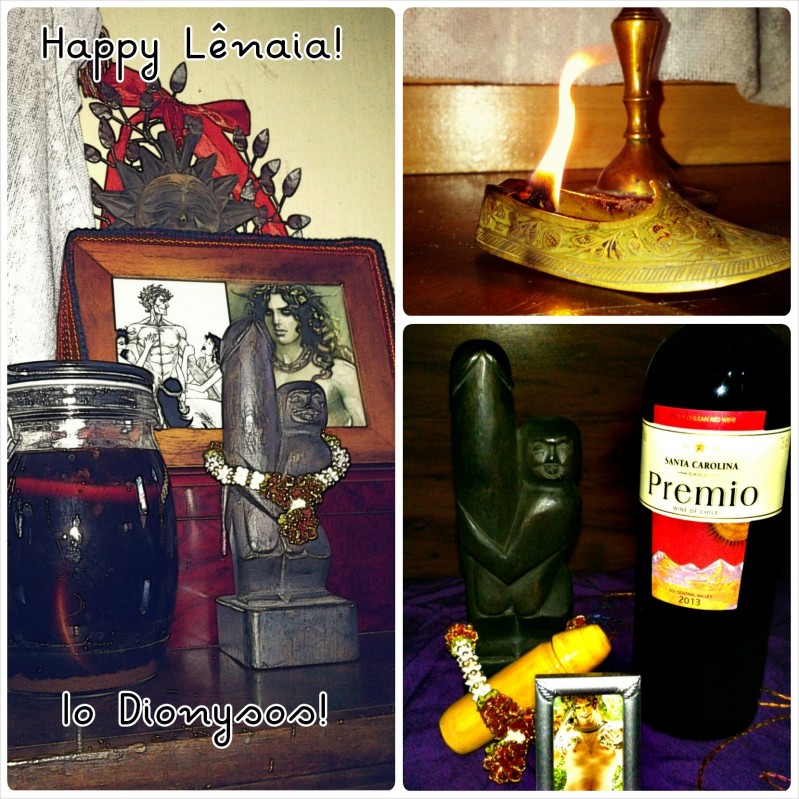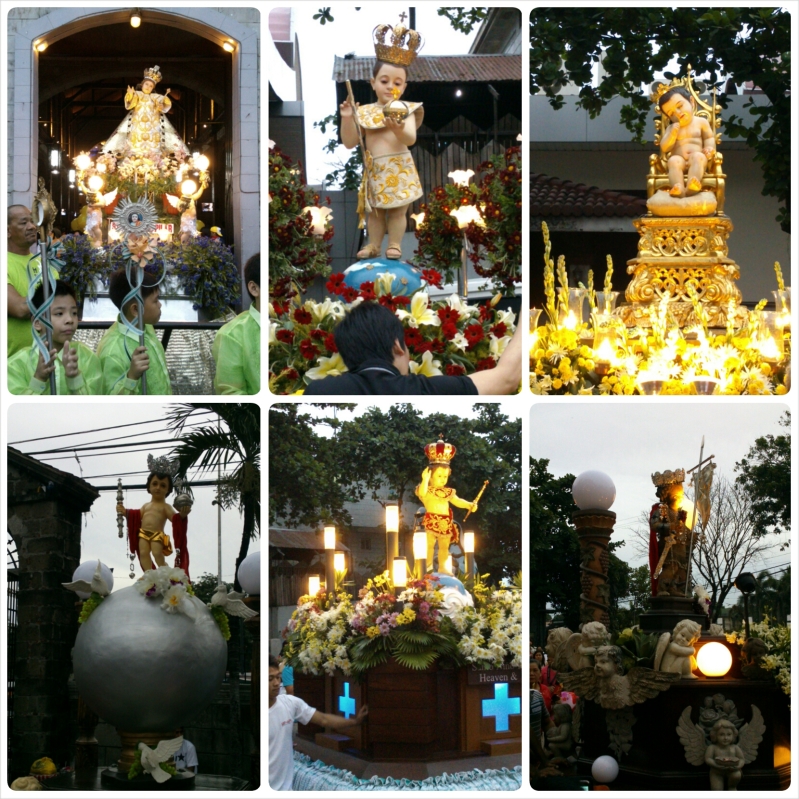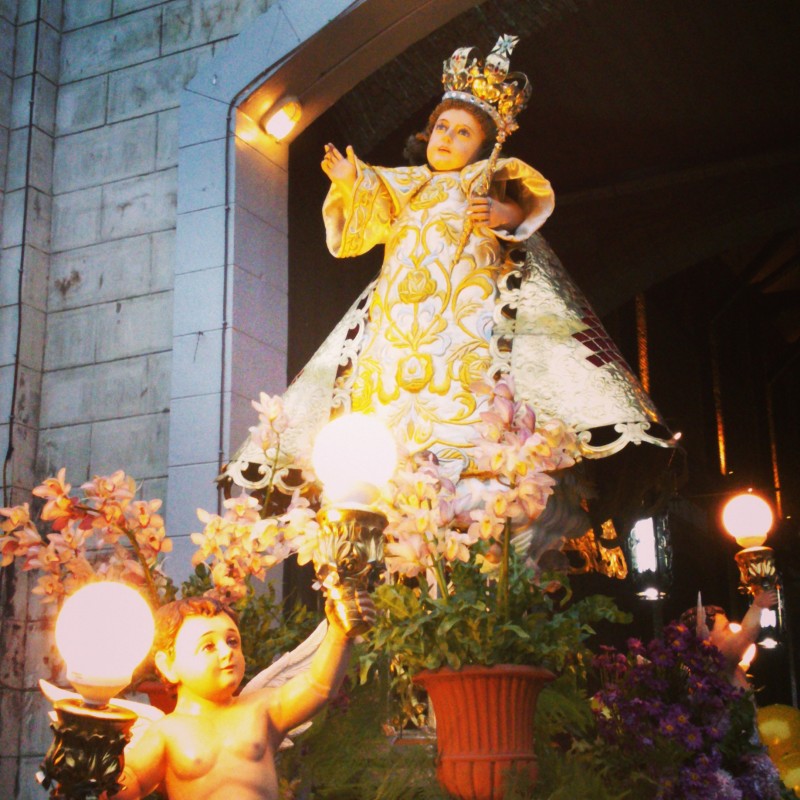Despite this sleepy, lazy January weather, there have been some interesting festivals lately, namely Lênaia and Sinulog.
Sannion offers us valuable information about the former:
The Lenaia was one of the most important festivals of ancient Athens — important not only as concerns the worship of Dionysos (as it is among his earliest attested festivals) but important to the Athenians in shaping their own civic identity. […] Lenaia appears to be an essential component of Dionysos’ winter festival cycle which culminates in Anthesteria. Coming in the middle as it does, the coldest and most barren part of the year, it is concerned with arousing and joyously placating the god so that he will have the power and inclination to bless the land with abundant fertility during his later marriage with the Basilinna. This is done in two ways — the procession, public sacrifice and theatrical performances of the city on one hand and the private banquet, dances and ecstatic worship of the lenai on the other. Both are intended to establish an amicable bond with the god — the public rites by reminding him of his visit to the city in the remote mythic past when he shared his gifts and brought civilized culture to the Athenians and more intimately with regard to the maenad priestesses. They clothe and decorate his idol, they sing and dance and play music for his entertainment, they share the remaining bounty of their fields with the god and they stir the wine as they hope he will stir the life-force in the frozen earth for them. In many ways a simple and unassuming festival — but absolutely essential for the well-being of the polis and to set the stage for the even more important Anthesteria. [See more.]
The official site of Sinulog also gives us a brief history of the celebration:
Sinulog is a dance ritual in honor of the miraculous image of the Santo Niño. […] Historical accounts say that before Portuguese navigator Ferdinand Magellan came to Cebu on April 7, 1521 to plant the cross on its shore and claim the country for the King of Spain, Sinulog was already danced by the natives in honor of their [anitos]. Then Magellan came and introduced Christianity. He gave the Santo Niño (image of the Child Jesus) as [a] baptismal gift to Hara Amihan, wife of Cebu’s Rajah Humabon who was later named Queen Juana.
Now, my Lênaia celebration this year was rather simple and private. I made mulled wine at home, sang one or two hymns, danced, watched a film, and offered my activities to Dionysos.

I also presented a wood carving of a fertility(?) anito from Banaue (a gift from Murmur) as a votive offering to Dionysos. Bless his cock and may he bless mine!
For Sinulog, I joined the local Catholic community (i.e. pretty much everybody else) in the annual procession of our town’s Baby Jesus collection.

Naturally, the Santo Niño has had countless forms in the past 400 years. One wonders if the various little lords have absorbed some of the local deities? I wouldn’t be surprised. Nowadays, there’s a Niño for everything: a policeman’s Niño, a fireman’s Niño, a businessman’s Niño, etc. Today, there isn’t a single Catholic-owned business that doesn’t have a red or green-robed Niño with a bag of coins. Very mercurial.

This particular Baby White Jesus is Santo Niño del Pilar, who looks over our city as the son of his mum, our patron, Nuestra Señora del Pilar.

Interestingly, a certain diwatà from the South was called “Santonilyo” and was regarded as a giver of good graces (again, quite mercurial). His name and function point to a very probable syncretism between an earlier diwatà (whose original name is now, unfortunately, lost to us) and the Santo Niño.
Art by squeegool (squeegool.deviantart.com)
Awesome myth-collector, Visayan Myths, goes on to say that:
When Magellan came to the Philippines and landed in Cebu in April 1521, he was received by Rajah Humabon and his wife Humamay (some sources say her name was Amihan) and requested them to pledge allegiance to Spain and to allow the catechists to do their work and spread the tenets of Christian faith. Within a week, the Rajah and the Queen were baptized and were given the Christian names Carlos (after Holy Roman Emperor Charles V) and Juana (after Joanna of Castile) and one of the scribes, Antonio Pigafetta, an Italian Chronicler presented to the Queen an image of the St. Niño, to which she fell in love with immediately and said she was ready to renounce her ‘animist ways’ and accept the Child Jesus, it was even reported that as she received the figure, she was overjoyed and wept, bathing the statue with her tears as she [was] hugging it, and after her baptism, 800 other Cebuanos were also baptized and were given an image of the Virgin Mary and Ecce Homo, a depiction of Jesus before Pontius Pilate and a crucifix.
But the Spaniards underestimated the power of the animist faith, as it [was] deeply ingrained within the people. A few days later, Magellan was shocked to discover that Rajah Humabon still kept his idols and was astounded by the discovery that, not only [were] animist shrines present in every home, but [could] also be found in fields and even in grave sites. It was thought that the Queen readily accepted the Sto. Niño because it looked more regal, refined, and decked out in foreign finery unlike her wooden larawan with tusks that looked old and grimy, coupled with the fact that the natives were in awe of their Spanish visitors. Nonetheless, sources say that Magellan became a champion of Rajah Humabon and requested all the other chiefs of Cebu to surrender, and he personally sailed to Mactan and, unbeknownst to him, Lapu Lapu was ready and waiting to strike them. Magellan died in that encounter, the Spanish forces retreated back to Humabon, but were unaware that the repudiation of the newfound faith [had] already started among Humabon’s people, abandoning the Catholic faith once more in favor of the old religion. On May 1, 1521, Humabon ordered the massacre of the Spanish Survivors during a banquet, and some of them (Pigafetta included), escaped back to Europe, and nothing was documented about what happened to the Sto. Niño image. [See more.]
Now, as much as I appreciate Christians admitting to a possible ‘pagan’ origin of one of the most celebrated festivals in the country, what I don’t appreciate is misleading history:
That several practices surrounding modern Sinulog couldn’t have come from Catholicism is a reasonable theory (I mean, where else could it have come from?), but as for actual, hard evidence (such as historical records), I don’t think we’ve got much to confirm that Sinulog is a direct holdover from Cebuano paganism. Sorry!
I reckon, we just have to take it for what it is: a possibly syncretic festival in honour of a possibly syncretic deity. And that’s fine, I guess! Minus the explicit glorification of Catholic imperialism, of course.
Nevertheless, hail thou, Dionyos of Athens! Hail thou, Baby Jesus of Cebu!




I am glad you and your family are safe! The Sinulog festival and others like it seem to showcase the beautiful drama both religions (Catholicism and the folk religion) can make! When I started looking toward my family heritage, the first and obvious evidence of their spirituality is Catholicism. Though, I do think that in taking on the Christian label and mantle, that perhaps some of the gods still carried on as various saints and guardians, like daimones (I think that’s the word?).
LikeLike
Oh, spot on! It seems that wherever Catholicism has made a strong presence, elements of the “conquered” religion survive, too.
LikeLike